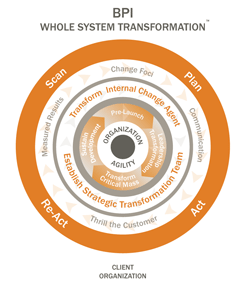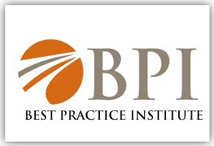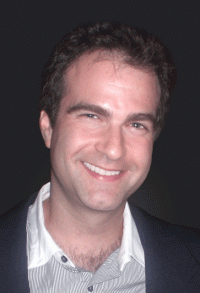
Questions for the founding & growth of The Best Practice Institute
QuestionsForLiving interview with Louis Carter March 28th, 2012 regarding the founding and growth of the Best Practice Institute.
QFL: Were there specific questions that led you to creating / founding the Best Practice Institute? If so, can you please provide some of the core questions that led to the creation of BPI?
Louis Carter: When founding BPI, I asked myself core questions in several areas surrounding its purpose, market need, and service to members.
How will creating BPI serve my higher purpose in life? In fact, it has and will continue to serve my higher purpose. My higher purpose is to help people transform themselves and others. People sometimes wonder what this means. This means you are having a positive impact on your organization and other individuals in your life. Whether it is integration of your talent management program, establishing more profitable growth, or taking off 15 lbs, you have transformed yourself and others. I think about it from this perspective:
- What have I done today that positively impacts another person, myself, or your organization?
- In what ways will I help make the lives of BPI's members better as a result of our work together?
- What are our world’s leading organizations doing by way of developing its leaders, managing talent, human resources, change, transformation, strategy, finance, marketing, operations, sales, and business development?
- Who is leading the way in pioneering, best and innovative practices?
- Who makes the world a better place to work?
QFL: What are some of the core questions that you have asked over the years that contributed to the overall success and continued growth of the Best Practice Institute?
LC: The key question I ask myself and my members is around adding more value and new innovative products for individual or organizational transformation.
How do I innovate to provide BPI's members with the best possible and highest quality content and peers?
My questions have brought me to a great deal of conclusions – some that have hit the mark and some that have missed by a mile or two. The newest innovations are around giving BPI Senior Executive Board members the opportunity to practice the discipline of Whole System Transformation in order to build the board as well as implement their change back on-the-job. By giving the peer network an opportunity to practice their vision with others through a disciplined practice, they are improving their skills for bringing it back on-the-job. Board members are given specific roles for design and facilitation of the session. They are given data that we collect to ground their design and facilitation decisions in data. The sessions achieve the same results they are seeking within their organizations. They then take the BPI- Whole System Transformation process back to work and make change happen there.
The other innovation we have been working on is the answer to a question: How do we create a transparent, open culture within our organizations? The answer has been in the creation of a social feedback tool. This social feedback tool validates skills through an open method of feedback. Can you imagine everyone in your organization and beyond sharing advice and rating on your skills? This is a revolution in organization transparency.
QFL: Are there any questions that led you personally toward, and currently fuel, your interest in studying and researching best practices within leading organizations? If so, what are some of these primary questions?
My personal journey toward best practices came from a deep analysis of my own mistrust of organizational systems. As an undergraduate, I created one of my college’s first course evaluation guides. I recruited 15 students to join my new organization. We collected over 1000 signatures to demand that we have the right to evaluate our courses and publish the results. We organized a college-wide student evaluation of all courses, collected the data, and published it. The day after we placed the assessments under each door of the classrooms, I received threats from professors in my mailbox. These threats included some interesting questions, “Who do you think you are?” “Why don’t you go to hell?” “Do you think you may want to go f— yourself?” These were great questions for me at the time.
The next day, I went to the Office of the President without an appointment. I walked in past the Executive Assistant who asked me if I had an appointment. You know the answer. I opened the President’s door and put the letters on her desk. She said, it’s time I give you an office and some money to make this happen. She passed $20,000 through the budget, assigned me my own building to set-up my office, and we began the journey.
How do organizational journeys begin? They begin with dissatisfaction. They begin with people who want to follow you. They begin with someone in power who believes in you.
The same process happened with Best Practice Institute. How do I open my eyes, ears, and heart to the world? I noticed the same level of mistrust and dissatisfaction at many of my colleagues workplaces. I began to see how the justice system worked and how through loopholes, criminals would be set free. I saw hospital systems mistreating their patients. With this vision, I asked, What do I do to begin spreading real change in the world of organizations? The answer was in the power of not one individual, but of the collective whole – an association, a board of individuals who believed in something greater than themselves. Individuals who wanted to transform themselves, others, and the field of change itself.
QFL: What are the primary / core questions that you ask for indentifying thought-leaders for specific best practice research initiatives and case studies and for BPI's Board of Leading Thinkers?
Over the years, I have assessed well over two thousand thought leaders. As you may imagine, I have some points of view on the subject. I have found that there is a great deal of replication of content. Some people do not live the change they seek in the world. They have a different set of interests that don’t match with a world in need. Who is telling the same story over and over again but in a different way? Is this person socially responsible? Does this person serve a higher purpose? Does this person practice what he/she preaches? How committed is this thought leader to his/her cause? I use the Ghandi Meter for assessing thought leaders. The range is Charley Sheen to Ghandi. Are they wild and irresponsible like Charley Sheen or are they willing to die for their cause like Ghandi?
QFL: What are your primary questions for successfully researching, compiling, and delivering Best Practice case studies that accurately represent best practices from a wide range of Fortune 500 and Global 1000 organizations worldwide?
I have six primary questions I ask for assessing a best practice. Each question represents different elements of the 6-element approach to best practices. Before he died, Richard Beckhard, former professor at MIT and author of Agents of Change and I evolved my phased approach into an elemental approach through his question, “Why are these ‘phases’?” We came to the conclusion that the different questions that are asked are not “phases” because they can happen at any time during the best practice analysis or repeat in a continuous evaluation cycle. You could be diagnosing one moment and then evaluate immediately. Or you could evaluate and then move directly to continuous improvement or design again. So, we called them elements. The first elemental question is: What led you to set out to do what you were going to do? The answer to this question enables us to understand the business case behind the best practice. The second question relates to Assessment: How did you test your assumptions about your business case? This leads us to learn more about the tools and methods the person used to verify or validate their assumptions. The third and fourth questions are around designing and implementing the best practice system itself. Who will be involved in the design team and what did they do to design and implement the best practice system? The fifth and sixth questions are around continuous support and evaluation: How do you ensure that the best practice system continues over time? And, what were the results of your best practice system?
QFL: Were there any specific questions that you were asking that led to BPI's "Best Practice Whole System Transformation Model and Process "? If so, what were some of these questions?
LC: Can a best practice truly be adopted and implemented verbatim in another organization? Our answer was unanimous, “Probably not.” Organizations must create their own best practice system based on a process of collaboration and co-creation. To develop our system, we interviewed 1000s of executives around two very simple questions, “What is your biggest challenge?” “How will you overcome this challenge?” After discussing these two questions in depth, we have come to a simple conclusion that when you let the organization take on the challenge, it will actually overcome its own challenges. We adopted models from Richard Beckhard and Kathleen Dannemiller on Whole System Change along with 100s of other theories around change to come up with this simple system for transformation. We asked ourselves, “Does this model fit our best practice analysis model?” "Will we be able to create a best practice through our system of transformation?"
Please note BPI's Transformation Model and Whole System Transformation Model, presented below.


We agreed that no one best practice can be replicated in another system without this process. And, indeed we were correct. Today, companies like Allstate, Airbus, BAE Systems, the Clinton Administration and countless others have began to adopt the transformation model within their organization. When you try to solve problems by selling one solution, you may win or lose — but when you give the tools for people to empower themselves and solve problems themselves, you will always win.
QFL: Were there any specific questions that you were asking that led to BPI's "Best Practice Systems Model"? If so, what were some of these questions?
When creating the BPI Best Practice Systems Model, we asked ourselves many questions around the validity of a best practice. We believe that best practices only exist within a specific organization context. One best practice is not necessarily compatible with another organization. Therefore, we asked, “What is the organization’s specific context for a best practice?” "What makes this particular organization unique?"
We adopted over 50 years of research into one model that encompasses all organizational realities. We asked, “What model will be agile enough to adapt to any organizational system?” "What model will not box us into one world view of best practices?"
We surveyed other companies implementing best practice methodologies. We found that they had one world view that best practices can be adopted anywhere. We turned this around and asked, “What can we do to make our model the most inclusive?”
QFL: Lastly, a general question that QFL has been including in thought-leader interviews... "What questions do you think people should ask themselves to make this world a happier and healthier place to live?"
There are a few universal rules of human behavior I believe everyone should live by: 1. Treat others with the same dignity and respect that you expect from others. 2. Always ask for what you want 100% of the time. 3. Exercise your right to choice at all times. 4. Balance your life giving equation. 5. Serve the greater good, 6. Always clear your feelings and thoughts with other people. Withholding feelings and thoughts creates a muddy world that is hard to navigate.
- What is your percentage of giving vs. receiving?
- What choices have you made today to make your life better?
- What choices have you made today to make someone else’s life better?
- What relationships don’t seem to be serving your highest best interests?
- Are you able to let go of what you think you know to serve the greater good?
- What relationship have you improved today?
- Have you cleared your beliefs with someone? Are you withholding information from someone that may adversely affect your relationship with them?
- What assumptions did you make that may have an impact on your or others behavior over time?
For further information, Lou Carter can be contacted at:
Louis Carter
Bio
Louis Carter founded BPI in 2001 and developed the organization to include tens of thousands of managers, executives and leaders of our world's best organizations. He has written over 8 books on best practices and organizational leadership including Change Champions, Best Practices in Talent Management and several other best practices books published by Jossey Bass/John Wiley and Sons. He has been interviewed, profiled and quoted by such publications as Business Watch Magazine, Workforce Magazine, Investor's Business Daily, Training Magazine, and CIO Magazine. Lou's research and teaching has been translated into over 8 languages across Asia, the Middle East, Europe, North and South America. He has taught at such universities as Tsinghua School of Business in Beijing, Jackson State University, and Seton Hall University. He has had the honor of performing benchmark research, organization development and analysis with nearly all Fortune/Global 500 organizations. Most of all, Lou appreciates and enjoys his family, friends, drumming, boating, boxing and working with the wonderful people on the BPI team.



Comments
Much needed work
Lou's commitment to individual and organizational excellence is much needed in an increasingly large scale and international world where assessment and action are hard to accomplish even from within organizations. Someone who strives to bring clariety and insight to a variety of complex and interrelated issues and contributing factors that can make real and lasting change is essential; perhaps even more essential than many care to confess.
-L.J. Acker